

Gutenberg Press. Johannes Gutenberg and the Printing Press. History: Reformation for Kids. History >> Renaissance for Kids The Reformation occurred during Renaissance times.
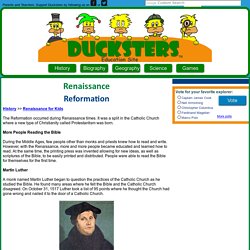
It was a split in the Catholic Church where a new type of Christianity called Protestantism was born. More People Reading the Bible During the Middle Ages, few people other than monks and priests knew how to read and write. Renaissance Period: Timeline, Art & Facts - HISTORY. The Renaissance was a fervent period of European cultural, artistic, political and economic “rebirth” following the Middle Ages.
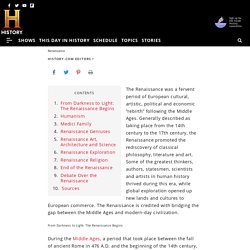
Generally described as taking place from the 14th century to the 17th century, the Renaissance promoted the rediscovery of classical philosophy, literature and art. Some of the greatest thinkers, authors, statesmen, scientists and artists in human history thrived during this era, while global exploration opened up new lands and cultures to European commerce. The Renaissance is credited with bridging the gap between the Middle Ages and modern-day civilization. Raphael, Marriage of the Virgin, 1504. Raphael, Marriage of the Virgin, 1504. The Marriage of the Virgin. Renaissance Art. Known as the Renaissance, the period immediately following the Middle Ages in Europe saw a great revival of interest in the classical learning and values of ancient Greece and Rome.

Against a backdrop of political stability and growing prosperity, the development of new technologies–including the printing press, a new system of astronomy and the discovery and exploration of new continents–was accompanied by a flowering of philosophy, literature and especially art. The style of painting, sculpture and decorative arts identified with the Renaissance emerged in Italy in the late 14th century; it reached its zenith in the late 15th and early 16th centuries, in the work of Italian masters such as Leonardo da Vinci, Michelangelo and Raphael. History: Renaissance Art for Kids. History >> Renaissance for Kids Many of the new ideas and attitudes that marked the Renaissance times were portrayed in art.
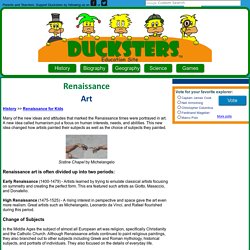
A new idea called humanism put a focus on human interests, needs, and abilities. GCSE Bitesize: Six key changes. Botticelli’s Birth of Venus – ItalianRenaissance.org. Aside from his painting of the Primavera, Sandro Botticelli’s other greatest work, done for the Medici family, is the Birth of Venus.
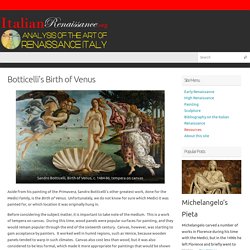
Unfortunately, we do not know for sure which Medici it was painted for, or which location it was originally hung in. Before considering the subject matter, it is important to take note of the medium. This is a work of tempera on canvas. During this time, wood panels were popular surfaces for painting, and they would remain popular through the end of the sixteenth century. Michelangelo’s Creation of Adam – ItalianRenaissance.org. Michelangelo, Creation of Adam, from the ceiling of the Sistine Chapel in the Vatican, Rome, 1508-1512, fresco The most famous section of the Sistine Chapel ceiling is Michelangelo’s Creation of Adam.

This scene is located next to the Creation of Eve, which is the panel at the center of the room, and the Congregation of the Waters, which is closer to the altar. The Creation of Adam differs from typical Creation scenes painted up until that time. Famous Paintings, Analysis, Interpretation. • Fouquet, Jean (1420-81) Portrait of Charles VII of France (1445-50) Louvre Museum, Paris Considered to be one of the greatest portrait paintings of the French school.

Melun Diptych (1450-55) Oil/panel, Koninklijk Museum; Gemaldegalerie, SMPK, Berlin This devotional diptych - commissioned by Etienne Chevalier, treasurer to King Charles VII - could easily be mistaken for a work of modern art, rather than an example of International Gothic. Fragonard, Jean-Honore (1732-1806) Vitruvian Man Da Vinci. Leonardo da Vinci The Humanist At Work - The Leonardo. Leonardo da Vinci: The Humanist At Work “Look upon the marvelous works of nature, if you judge it to be an atrocious act to destroy them, reflect that it is an infinitely atrocious act to take away the life of man.” – Leonardo da Vinci.
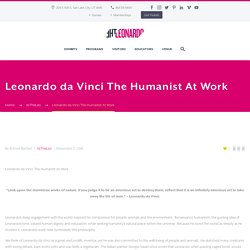
Leonardo’s deep engagement with the world inspired his compassion for people, animals and the environment. 3 Characteristics of Renaissance Art That Changed the World. The word Renaissance means “rebirth”. Following the Dark and Middle ages and their associated turmoil and stagnation, not to mention the Black Death, Europe experienced a rebirth of sorts with a rediscovery of math, philosophy, astrology, astronomy, science, and literature and art witnessed a great revival within the 200 years, i.e., from 1400 to 1600. While many principal characteristics of renaissance art have been influencing the modern world, this phase had led towards a spiritual thinking wherein people began exploring the philosophy of humanism With the advent of the printing press, knowledge was for the first time in over 1000 years accessible to people outside of the clergy, the noble, the aristocratic, and the royal.
Special attention was given to the classical eras in Greece and in Rome, which until the Renaissance were the pinnacle of human achievement. Renaissance Art: History, Characteristics. History of Renaissance Art The Renaissance, or Rinascimento, was largely fostered by the post-feudal growth of the independent city, like that found in Italy and the southern Netherlands.
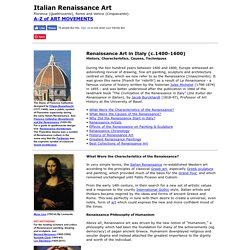
Grown wealthy through commerce and industry, these cities typically had a democratic organization of guilds, though political democracy was kept at bay usually by some rich and powerful individual or family. Good examples include 15th century Florence - the focus of Italian Renaissance art - and Bruges - one of the centres of Flemish painting. Expulsion from Paradise by Michelangelo. Children's Bible stories. Michelangelo’s Painting of the Sistine Chapel Ceiling – ItalianRenaissance.org. Michelangelo, Sistine Chapel Ceiling, 1508-1512, fresco The Sistine Chapel is one of the most famous painted interior spaces in the world, and virtually all of this fame comes from the breathtaking painting of its ceiling from about 1508-1512.

The chapel was built in 1479 under the direction of Pope Sixtus IV, who gave it his name (“Sistine” derives from “Sixtus”). The location of the building is very close to St. Peter’s Basilica and the Belvedere Courtyard in the Vatican. The Story Behind Raphael's Masterpiece 'The School of Athens' This post may contain affiliate links. If you make a purchase, My Modern Met may earn an affiliate commission. Please read our disclosure for more info.